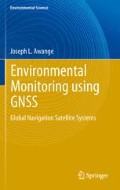Abstract
Environmental monitoring has been defined as the observation and study of the environment. This entails objective observations that produce sound data, which in turn produce valuable information that is useful, e.g., in the protection of public water supplies, hazardous, non-hazardous and radioactive waste management, natural resource protection and management, weather forecasting, and global climate change studies.
“If environmental monitoring is not carried out in a deep and exacting scientific manner, then it is likely that no action will be taken when needed for lack of firm evidence.” Frank Burden.
Access this chapter
Tax calculation will be finalised at checkout
Purchases are for personal use only
References
Artiola J, Pepper IL, Brusseau ML (eds) (2004) Environmental monitoring and characterization. Elsevier Academic Press, San Diego
Awange JL, Sharifi M, Ogonda G, Wickert J, Grafarend EW, Omulo M (2008) The falling lake victoria water level: GRACE, TRIMM and CHAMP satellite analysis. Water Resour Manag 22:775–796. doi:10.1007/s11269-007-9191-y
Barbari M, Conti L, Koostra BK, Masi G, Sorbetti Guerri F, Workman SR (2006) The use of global positioning and geographical information systems in the management of extensive cattle grazing. Biosyst Eng 95(2):271–280. doi:10.1016/j.biosystemseng.2006.06.012
Bonner MR, Han D, Nie J, Rogerson P, Vena JE, Freudenheim Jo L (2003) Positional accuracy of geocoded addresses in epidemiologic research. Epidemiology 14:408–412. 10.1097/01.EDE.0000073121.63254.c5
Burden FR, McKelvie I, Förstner U, Guenther A (2002) Environmental monitoring handbook. McGraw-Hill, New York
Downes BJ, Barmuta LA, Fairweather PG, Faith DP, Keough MJ, Lake PS, Mapstone BD, Quinn GP (2002) Monitoring ecological impacts: conceipts and practise in flowing waters. Cambridge University Press, Cambridge
Durner GM et al. (2009) Predicting 21st-century polar bear habitat distribution from global climate models. Ecol Monogr 79:25–58. doi:10.1890/07-2089.1
Finlayson CM (1996) Framework for designing a monitoring program. In: Tomas Vives P (ed) Monitoring mediterranean wetlands: a methodological guide. Med-Wet publication, Wetlands International, Slimbridge, UK and ICN, Lisbon
Fischbach FF (1965) A satellite method for pressure and temperature below 24 km. Bull Am Meteorol Soc 46:528–532
Gibson J, MacKenzie D (2007) Using global positioning systems in household surveys for better economics and better policy. World Bank Res Obs 22(2):217–241. doi:10.1093/wbro/lkm009
Goldsmith FB (ed) (1995) Monitoring for conservation and ecology. Chapman and Hall, London
Hebblewhite M, Haydon DT (2010) Distinguishing technology from biology: a critical review of the use of GPS telemetry data in ecology. Philos Trans R Soc B 365:2303–2312. doi:10.1098/rstb.2010.0087
Hofman-Wellenhof B, Lichtenegger H, Collins J (2001) Global positioning system: theory and practice, 5th edn. Springer, Wien
Hofman-Wellenhof B, Lichtenegger H, Wasle E (2008) GNSS global navigation satellite system: GPS, GLONASS; Galileo and more. Springer, Wien
Huete AR (2004) Remote sensing for environmental monitoring. In: Artiola J, Pepper IL, Brusseau ML (eds) Environmental Monitoring and Characterization. Elsevier Academic Press, San Diego
James LF, Young JA, Sanders K (2003) A New approach to monitoring rangelands. Arid Land Res Manag 17:319-328. doi:10.1080/15324980390225467
Kitron U (1998) Landscape ecology and epidemiology of vector-borne diseases: tools for spatial analysis. J Med Entomol 35(4):435–445
Larson LW (1996) Destructive water: water-caused natural disasters, their abetment and control. IAHS conference, Anaheim California, 24–28 June 1996
Lillesand TM, Kiefer RW, Chipman JW (2008) Remote sensing and image interpretation, 6th edn. Wiley, Hoboke
Macarthur R (2004) Geographical information systems and their use for environmental monitoring. In: Artiola J, Pepper IL, Brusseau ML (eds) Environmental monitoring and characterization. Elsevier Academic Press, San Diego
Mackenzie FT (2003) Our changing planet; an introduction to Earth system science and global environmental change. 3rd edn, Prentice Hall, New Jersey
Melbourne WG, Davis ES, Duncan CB, Hajj GA, Hardy K, Kursinski R, Mechan TK, Young LE, Yunck TP (1994) The application of spaceborne GPS to atmospheric limb sounding and global change monitoring. JPL Publication, Pasadena, pp 94–18
Nittel S, Labrinidis A, Stefanidis A (eds) (2008) GeoSensor networks. Lecture notes in computer science, vol 4540. Springer, Berlin, pp 1–6.
Seidel DJ, Randel WJ (2006) Variability and trends in the global tropopause estimated from radiosonde data. J Geophys Res 111:D21101. doi:10.1029/2006JD007363
Spellerberg IF (2005) Monitoring ecological change, 2 edn. Cambridge University Press
Steede-Terry K (2000) Integrating GIS and the global positioning system. ESRI Press, California
Study of Critical Environmental Problems (1970) Man’s impact on the global environment. MIT Press, Cambridge
Taylor MAP, Woolley JE, Zito R (2000) Integration of the global positioning system and geographical information systems for traffic congestion studies. Transp Res Part C 8(1–6):257–285. doi:10.1016/S0968-090X(00)00015-2
Thirgood S, Mosser A, Tham S, Hopcraft G, Mwangomo E, Mlengeya T, Kilewo M, Fryxell J, Sinclair ARE, Borner M (2004) Can parks protect migratory ungulates? The case of the Serengeti wildebeest. Animal Conserv 7:113–120. doi:10.1017/S1367943004001404
Urbano F, Cagnacci F, Clement C, Dettki H, Cameron A, Neteler M (2010) Wildlife tracking data management: a new vision. Philos Trans R Soc B 365:2177–2185. doi:10.1098/rstb.2010.0081
Vaughan H, Brydges T, Fenech A, Lumb A (2001) Monitoring long-term ecological changes through the ecological monitoring and assessment network: Sciencebased and policy relevant. Environ Monit Assess 67(1–2):3–28, doi:10.1023/A:1006423432114
Wickert J (2002) Das CHAMP-Radiookkultationsexperiment: algorithmen, Prozessierungssystem und erste Ergebnisse. Dissertation, Scientific Technical Report STR02/07, GFZ Potsdam
Wiersma GB (ed) (2004) Environmental monitoring. CRC Press, Boca Raton
Author information
Authors and Affiliations
Rights and permissions
Copyright information
© 2012 Springer-Verlag Berlin Heidelberg
About this chapter
Cite this chapter
Awange, J.L. (2012). Environmental Monitoring. In: Environmental Monitoring using GNSS. Environmental Science and Engineering(). Springer, Berlin, Heidelberg. https://doi.org/10.1007/978-3-540-88256-5_1
Download citation
DOI: https://doi.org/10.1007/978-3-540-88256-5_1
Published:
Publisher Name: Springer, Berlin, Heidelberg
Print ISBN: 978-3-540-88255-8
Online ISBN: 978-3-540-88256-5
eBook Packages: Earth and Environmental ScienceEarth and Environmental Science (R0)

